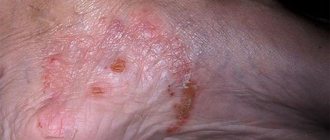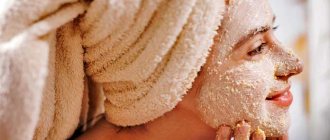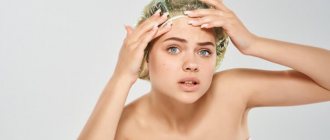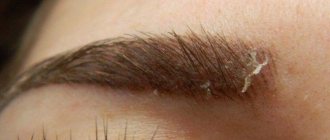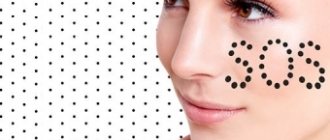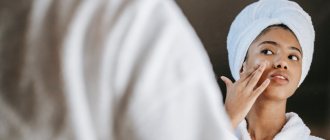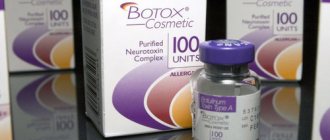Causes of hyperpigmentation.
In men and women, pigmented formations appear for several reasons.
- Exposure to ultraviolet rays in a solarium or outdoors. Due to the fact that when exposed to ultraviolet rays, the skin synthesizes melanin, which is what causes a tan. But, if you overexpose yourself to the sun or in a solarium, then excessive pigmentation appears.
- The cause of pigmentation may be changes in hormonal levels. The point again is melanin, the production of which is not least responsible for the endocrine glands that synthesize hormones.
- Pregnancy, during which powerful hormonal changes occur, can trigger the appearance of spots.
- Pigmentation may appear after injury. The integrity of the skin is compromised and post-traumatic hyperpigmentation occurs.
- Taking some medications can cause side effects such as excessive skin pigmentation.
- Liver diseases very often affect the appearance, including the appearance of age spots.
- Poor quality and incorrectly selected cosmetics contribute to changes in the skin.
- Various inflammations are a concomitant factor for pigmentation.
- Hormonal birth control pills provoke unnecessary pigmentation.
- Sometimes there is a hereditary factor.
These are the main reasons, there are others, for example, the performance of cosmetic procedures by people who do not have the appropriate professional skills and specialization.
Causeless manifestations
It happens that people try to protect their skin, use special sunscreens, but hyperpigmented areas still appear. It's like it happens for no apparent reason. However, for melanocytes to malfunction, even a small but prolonged stress or temporary hormonal imbalance is enough.
It is also worth noting the cumulative negative effect of ultraviolet radiation, which can manifest itself over the years on areas of the body that received sunburn in early childhood. Therefore, only at first glance it seems that hypermelanosis arose without provoking factors. In fact, he has hidden reasons.
What are pigment spots?
- Lenitigo is a benign skin growth that is black or dark brown in color.
- Freckles are a congenital hyperpigmentation most often observed in fair-skinned and red-haired people. The color of the freckles is light.
- Melasma appears on the face, shoulders, and neck under the influence of hormones and ultraviolet radiation. May occur when using certain oils, especially citrus and mineral oils. Melasma becomes lighter in winter and darker in summer because it is very sensitive to ultraviolet radiation.
- Chloasma is brown or light brown spots of uneven shape. They have the character of focal hyperpigmentation of various sizes with clear boundaries. For the most part, such spots appear due to diseases of the internal organs.
Diagnostics
Diagnosis of the cause that caused one or another type of skin pigmentation disorder is based on examination and questioning of the patient, and taking an anamnesis.
Particular attention should be paid to melanomas with ill-defined edges and a size greater than 5 mm. Such a formation may turn out to be a malignant tumor.
Often, changes in pigmentation may indicate serious internal diseases, so additional tests and tests may be prescribed to make an accurate diagnosis:
- general and biochemical blood tests;
- urine and stool tests;
- Ultrasound of internal organs;
- blood test for various infections;
- examination of the tumor for the presence of cancer cells.
How to treat age spots?
Today, there are several ways to treat hyperpigmentation.
There are also folk remedies, but they not only do not provide a guaranteed result, but can also harm the skin.
The best and most reliable way is laser treatment or phototherapy. It's fast and efficient. In our laser cosmetology clinic “Laser Aesthetic”, to remove age spots, we use modern laser devices Candela and Lumenis IPL QUANTUM, which are recognized as the safest in the world! Call us or leave a request on the website to sign up for the procedure.
Milia on the face: why do they appear and how to get rid of them?
Milia on the face: why do they appear and how to get rid of them?
Whiteheads or milia are difficult to remove, which is especially annoying for their owner. But, fortunately, there are effective ways to get rid of this defect. Services Expert Clinics Peeling (cleansing) of facial skin Peeling helps renew the epidermis; it involves not only the upper thin layer, but also the deeper ones. Peeling (cleansing) of the facial skin Analyzes: comprehensive laboratory diagnostics Comprehensive laboratory diagnostics will identify obvious and hidden deficiencies, disorders and predisposition to certain diseases. Tests: comprehensive laboratory diagnostics Treatment of acne (acne) To protect yourself from the appearance of such an aesthetic defect as acne, you should follow the rules. Treatment of acne (acne) Call me back What is milia Milium is a cystic formation at the mouth of the hair follicle, looking like a small white grain. They are also called “millet” because they resemble millet grains in color and size. They usually appear where the skin is relatively thin (periorbital area, cheekbone, eyelids, forehead) and do not cause any physical discomfort. The contents that accumulate in the milia are a mixture of sebum, keratin, and keratinized particles. The nature of the rashes is non-inflammatory, so they do not cause harm to the body. They can appear either singly or form a focus. Types and causes of whiteheads The appearance of primary milia is associated with the functioning of the sebaceous gland. With its hyperfunction, the composition of sebum changes, a deficiency of valuable lipids is observed, which creates a favorable background for the occurrence of whiteheads. Secondary (they are often called Balser's pseudomilium) can be the result of trauma to the skin surface. Since milia are comedogenic phenomena, their appearance may be influenced by the following factors: · Hereditary predisposition. The peculiarities of the functioning of the sebaceous gland, the sensitivity of receptors to hormones, and the tendency to acne are determined and encoded by a large number of genes. · Hormonal imbalance. The sebaceous gland is hormone dependent. First of all, from testosterone and its active forms. Therefore, with hyperandrogenism, diseases of the pancreas, adrenal glands, and ovaries, the appearance of oily sheen, blackheads, acne, and milia is observed. They can also occur in newborns, as they undergo a hormonal crisis, but disappear after about a month. · Hyperkeratosis. These are thickenings of the stratum corneum of the epidermis. It may occur as a result of vitamin A deficiency, unfavorable external factors, or intoxication in hazardous industries. Hyperkeratosis leads to a slowdown in the rate of exfoliation of dead cells, resulting in a blockage of the sebaceous gland. · Metabolic processes disorders. The disease is based on the development of insulin resistance, for example, due to obesity. This can be facilitated by a sedentary lifestyle, frequent consumption of foods with a high glycemic index, psychological experiences, and hormonal disorders (hypothyroidism). · Gastrointestinal diseases. The appearance of a large number of milia can be affected by diseases associated with impaired outflow of bile: biliary dyskinesia, cholecystitis, bile stagnation. · Inappropriate cosmetic care. Neglecting hygiene rules or, on the contrary, using aggressive products can harm the skin. In the periorbital area, “bleaching” may appear due to the use of products not intended for the area around the eyes. How to get rid of milia on the face using cosmetic methods The main method of treatment is opening and removing the contents of the milia. It should be carried out exclusively in the office of a competent and experienced cosmetologist. · At the initial stage, superficial chemical peeling will help to partially unblock the head of the wen. Under the influence of fruit acids, dead skin cells dissolve, which gives a signal to renew the epidermis. Depending on existing problems and skin type, the peeling course ranges from 5 to 7 sessions. · Mechanical method (opening and curettage). Getting rid of milia is carried out by puncture with a needle. If the white wen is of medium size, then a Vidal needle is used. An insulin and mesotherapy syringe can work with smaller white dots. The cosmetologist opens the lining of the wen and removes the keratin clot using a curette and a Uno spoon. This method allows you to completely remove the contents and prevent the formation of new cysts. However, milia may appear on the face and body, the size of which does not allow them to be opened. In this case, the following will help: · Electrocoagulation. The procedure involves drying the wen using a high-frequency electric current, as a result of which they disappear on their own. · Laser removal. It is used for multiple localization and difficult to reach milia. The fatty tissue is removed with a laser, and the wound heals under a dry crust in 7-14 days. In this way, the skin is cured of cystic formations. Is it possible to remove milia at home? The exact and confident answer is no. The upper part of the milia is completely clogged, making their removal difficult even with specialized equipment. Under no circumstances should you try to squeeze out the formations yourself, as you can cause an infection and provoke inflammation. Incorrect and unprofessional exposure will lead to the appearance of even larger cosmetic defects - scars. Prevention of whiteheads Prevention of milia is no different from classic and high-quality care. Therefore, following some rules will become a multifunctional approach on the path to healthy and beautiful skin of the face and body. With the help of a cosmetologist, select a set of cosmetics suitable for your skin type. We remind you that it should include cleansing, toning and moisturizing + using peels and masks 1-2 times a week. Get tested. A deficiency or excess of certain elements can significantly harm the quality of the skin. Regularly visit a cosmetologist, in whose office you will undergo monthly skincare procedures: facial cleansing, peelings. Review your food intake and start keeping a food diary. This way you will know exactly which foods are in excess in your diet. It is advisable to completely exclude fried, salty, unhealthy foods, as well as foods rich in preservatives and dyes. Protect your skin from harmful UV rays with a highlighter spf cream 30-50. Sign up for a consultation
2021-07-30
2021-08-18
Expert Clinics
Expert Clinics
Milia on the face: why do they appear and how to get rid of them?
Milia on the face: why do they appear and how to get rid of them?
Milia on the face: why do they appear and how to get rid of them?
Treatment
The treatment is complex. Selected by a doctor. Therapy is selected individually. It is necessary to take into account the diagnosis and the degree of neglect of the pathology.
If treatment is ineffective, the selected therapy should be reconsidered.
Use of drugs
Drug treatment is most effective. Medicines are selected taking into account the cause that caused the disorder. Additionally, you need to take vitamin supplements to generally maintain your general condition.
When are antibiotics needed?
Antibiotics are necessary for infectious diseases. The course of treatment lasts 7 days. The doctor selects the appropriate medications.
The most effective include Ciprofloxacin .
Who is prescribed antifungal drugs?
The drugs are aimed at fighting the fungus. Requires taking 1 tablet per day or applying ointment 2-3 times a day. Lamisil is considered an effective drug .
Before using the tablet form, you must consult a doctor.
Preparations for lichen
To combat lichen the following is prescribed:
- salicylic acid;
- ointments based on birch tar;
- antihistamines.
The drugs are used in combination.
Birch tar
Fenistil
Salicylic ointment
Purposes of using glucocorticosteroids
Such drugs are aimed at eliminating the inflammatory process. Mandatory prescription for hypomelanosis. Among the most effective drugs in this group is Prednisolone .
White spots on the neck and body can be eliminated with glucocorticosteroids only through a course of treatment. Duration of therapy is 2 weeks.
Other drugs
Additionally, patients are prescribed immunomodulators, for example, Isoprinosine . The medicine is taken daily, 1 tablet. The course of treatment is selected individually.
Be sure to use vitamin supplements. This is necessary to strengthen the immune system.
Physiotherapy
The patient is referred for physical therapy.
Effective procedures include:
- ultraviolet therapy;
- PUVA therapy;
- heliotherapy;
- copper electrophoresis.
Physiotherapy is recommended when neoplasms of a benign or malignant nature are detected in the patient’s body. Without it, it will not be possible to get rid of tumors. Some of the listed methods of physical treatment are not prescribed to patients under the age of 18 years.
UV and PUVA therapy
PUVA therapy is also called photochemotherapy. The method involves alternating exposure to medications and ultraviolet rays. For skin problems, a systematic approach is effective.
Patients are prescribed surfactant baths. The patient is required to take a bath with a psoralen solution. After this, UV irradiation is used.
UV or ultraviolet therapy lasts up to 6 months. First, you need to attend the procedure every other day. Over time, the frequency decreases.
Traditional therapy
The consumption of St. John's wort, duckweed and parsnip activates the production of melatonin. These plants can also be used to treat affected areas.
A complex natural medicine is used to treat the skin. To prepare, mix equal amounts of chamomile, plantain and sage. The dry mixture is poured with boiling water and left for 30 minutes. Wipe the white areas with the resulting liquid 3 times a day.
The stain can also be wiped with melon juice.
Skin graft
Skin grafting is a surgical procedure. The patient is referred for autodermoplasty. For the operation, a skin flap is taken.
Dermoplasty is suitable for the face. If the affected area is large, your own skin may not be enough.
Epidermis transplantation is resorted to as a last resort. This is possible when traditional methods have proven ineffective.
Nutrition correction
You definitely need to reconsider your diet. Poor nutrition is one of the common causes of skin formations. Nutrition correction is part of complex treatment.
You will have to give up:
- strong coffee;
- cocoa;
- smoked and sausage products;
- spicy dishes;
- alcohol;
- confectionery products;
- canned food;
- blueberries;
- chocolate;
- pepper
The diet should be balanced. It is better if the portions are small but frequent. Additionally, you need to drink 1.5-2 liters of water per day.
You need to give preference to lean meats. The diet must include porridge. Fruits and vegetables are healthy. Once a day you need to drink fermented milk products.
Solarium - is it harmful?
It is also a mistake to think that sun tanning is harmful, and nothing will happen in specialized salons in a few minutes. On the beach, the skin gets a lot of heat, but this happens gradually. In the booths, a loading dose of ultraviolet radiation is given in a few minutes, which is difficult to obtain outdoors even in a whole day.
People with a fair skin type, with the presence of moles and nevi, freckles, existing aesthetic defects in the form of increased melanin production, need to get rid of the habit of visiting a solarium. The consequences can be expressed both in the progression of unsightly changes in the epidermal layer, and in their degeneration into malignant neoplasms.
Prevention
Skin can be preserved without defects by following preventive measures.
Doctors recommend:
- tanning in doses;
- use sunscreen when tanning;
- refuse to visit the solarium;
- Healthy food;
- to refuse from bad habits;
- maintain personal hygiene;
- drink enough clean water.
It is important to monitor your body and consult a doctor promptly if unwanted symptoms appear. Prevention significantly reduces the likelihood of developing depigmented areas.
